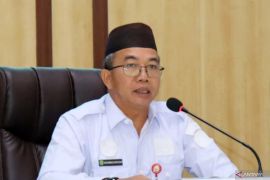Jakarta (ANTARA) - Deputy for Coordination of Social Welfare Improvement at the Coordinating Ministry for Human Development and Culture Nunung Nuryantono projected Indonesia's extreme poverty rate to decline to 0.8 or 0.9 percent at the end of 2023.
"As of March 2023, it has reached 1.12 percent. Hopefully, at the end of the year, it will be at 0.8 or 0.9 percent," he noted when contacted by ANTARA here on Saturday.
According to Nuryantono, the figure is based on the roadmap that aligns with Presidential Instruction Number 4 of 2022 on the Acceleration of Extreme Poverty Eradication, in which the extreme poverty rate is targeted to be at zero percent in 2024.
Nuryantono also stated that based on the National Socioeconomic Survey (Susenas), the extreme poverty rate as of September 2022 stood at 1.74 percent, while based on the same survey, as of March 2023, the rate declined to 1.12 percent.
He noted that three big strategies for handling extreme poverty are decreasing the burden of poor families through assistance programs, such as the Family Hope Program (PKH) and Direct Cash Assistance (BLT); increasing income; and reducing poverty pockets through infrastructure and sanitation improvement.
The Ministry of Villages, Development of Disadvantaged Regions, and Transmigration (PDTT), as one of the state institutions that supported the handling of extreme poverty, has utilized village funds to provide assistance to people categorized as extremely poor.
"The steps that are taken are starting from validating data and also encouraging village governments to target the three big strategies in village funds management," the ministry's Director General of Village and Rural Development, Sugito, stated when contacted by ANTARA on Saturday.
Sugito explained that in the utilization of village funds, village governments can allocate up to 25 percent of village funds for providing Village Fund Direct Cash Assistance (BLT DD).
In 2023, the ministry disbursed a total of Rp70 trillion (around US$4.61 billion) for 75,265 villages.
According to Sugito, villages have a central role in handling extreme poverty.
Executive Director of the Center of Economic and Law Studies (Celios) Bhima Yudhistira noted that the target of reaching zero-percent extreme poverty in 2024 is a major challenge due to the conditions of infrastructure in several regions.
"Locations inhabited by extremely poor people are usually in remote villages, and access to education and health facilities is still difficult," he stated when contacted by ANTARA on Saturday.
To this end, he assessed that the main aspect in alleviating extreme poverty is constructing connecting roads and other public facilities to make it easier for the government to distribute assistance.
Related news: Optimistic of eliminating extreme poverty next year: Ministry
Related news: Government implements three strategies to lower extreme poverty










